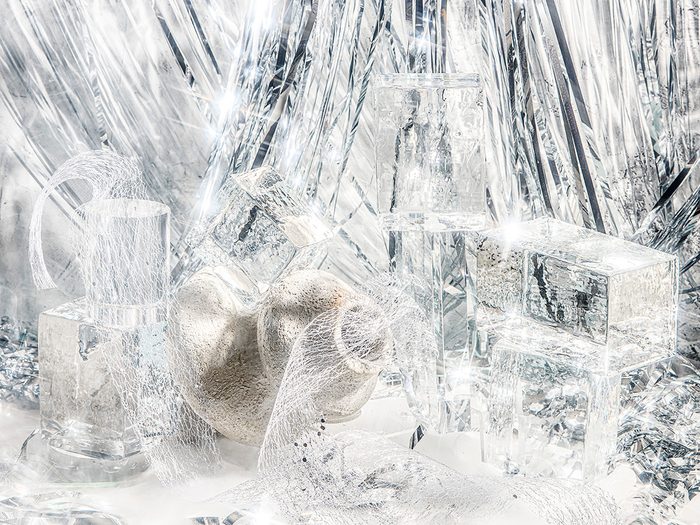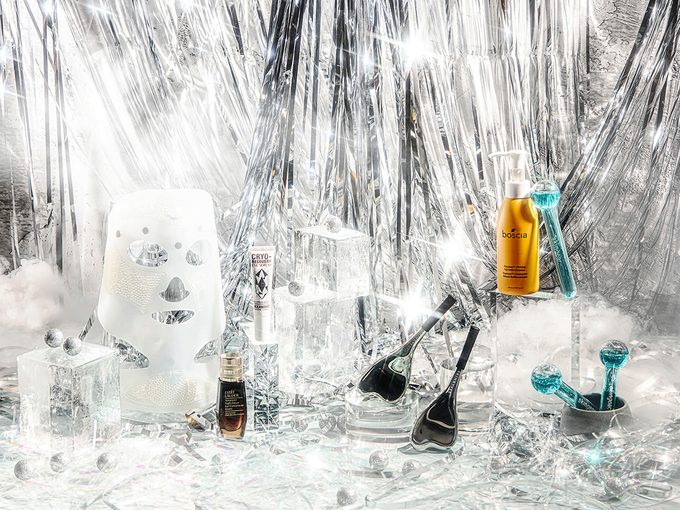Currently Trending: Cryotherapy-Based Skin Care Products

Ice sticks, chilled application wands and cooling masks are popping up on store shelves nationwide. Is cold therapy the magic beauty tool we’ve been searching for? Experts weigh in.
Pimples are like low-rise jeans—you think you left them in the past, but they make a sudden and unpleasant comeback 15 years later. Unlike low-rise jeans, however, I’ve found a way to make pimples a little more tolerable.
When a super red pimple emerges, I don’t squeeze, pop or poke it anymore. Impressed? Me too. It’s because I’ve learned a much more effective method for handling it, involving a special tool in my freezer—a shot glass full of ice.
My pimple-fighting journey began the first week of the pandemic. Stress had caused my skin to resemble a pizza pie, so I frantically hopped on a video call with New York-based aesthetician Sofie Pavitt to figure out what to do. She gave me a strict new skin care routine that included both acne- and acne-scar-fighting ingredients, as well as the instruction to apply ice to my blemishes for a few seconds in the morning and again at night. Pavitt says ice can be a fast way to soothe inflammation, reducing the size and redness of pimples, and making it an integral (and cost-effective) part of a pimple-fighting regimen. Since then, ice has become my low-tech version of a new beauty trend based on cryotherapy.
You might’ve heard of cryotherapy, a super cold body treatment offered in professional settings, where you stand naked in a “chamber” of liquid nitrogen (also known as dry ice) that produces a torturously frosty temperature for about three minutes—or until you can no longer bear it. The supposed reward is reduced inflammation, increased mind clarity and pain relief. The benefits don’t stop there: Cryotherapy can even help treat anxiety and depression in the short term, as it can activate the part of the brain that plays a role in motivation, emotion, and stress and pain responses by triggering the release of beta-endorphin hormones that offer a sense of elation.
Although cryotherapy has been Instagrammed by celebs lately, it’s not new. It was first used in a clinical setting in 1970s Japan, where a professor successfully treated rheumatism with extreme cold-water body immersion. And Danes have long been fond of winter swimming followed by a sauna for a reputed boost in energy and feel-good endorphins.
In Canada and the United States, cryotherapy is commonly used in sports medicine. Studies show cold immersion therapy aids in injury recovery and the prevention of exercise-induced soreness. And the cold smoke dermatologists use to freeze off warts and cancerous cells? That’s cryotherapy too. Now, it has a whole new purpose in a beauty treatment, even being dubbed “frotox” for its skin-tightening benefits.
Fans tout cryotherapy’s anti-aging, soothing and de-puffing abilities. Often added on to a conventional facial, the treatment involves blowing ice-cold air across the face to penetrate the pores and trigger a skin-tightening sensation. While more studies need to be done on its anti-aging benefits (there are claims cryotherapy can aid cellular renewal and collagen production), one study showed it can reduce dermatitis symptoms.
Today, many brands are taking advantage of the skin-improving benefits of cold therapy, launching cryotherapy-inspired beauty products for home use. There are iced glass sticks, eye creams with cooling stainless steel applicators, cooling masks, cooling cleansers and chilled gua sha wands, all promising to soothe and regenerate the face.
Do they actually work? “Any form of cryotherapy will provide some benefit,” says Dr. Dendy Engelman, celebrity dermatologist and cosmetic surgeon in New York City who partnered with Charlotte Tilbury for the release of the brand’s new cryotherapy products. While results can be more dramatic after a professional treatment, DIY alternatives still do the trick. With cryotherapy, results are immediate, says Engelman, as skin becomes instantly tighter, de-puffed and less red.
The main allure of these cryo-inspired beauty tools might just be their convenience. “Anyone can quickly reap the benefits of simple cryotherapy at home,” says Engelman. “Holding a frozen spoon to your undereye area will help with de-puffing, and a beauty tool that’s designed for cryotherapy can be used all over the face to not only deliver cold to the skin, but also to massage, contour and stimulate blood flow.” The process can also boost the efficacy of your skin care products by drawing them deeper into the skin as blood vessels contract, she says.
While such chilly beauty tools can be incorporated into an everyday beauty routine, one of the best times to consider using them is after a skin procedure (such as a laser treatment) to soothe swelling and redness, says Dr. Marni Wiseman, a dermatologist at Winnipeg’s Skinwise Dermatology clinic. Plus, the cold can help alleviate any discomfort caused by the procedure.
But icer beware: Wiseman cautions against using an ice cube and suggests reaching for a chilled product, like a stainless-steel applicator, as they’re safer to use. “Applying ice directly to the skin can actually cause freezing of the skin that’s equated to frostbite,” she says. If you choose to use ice or an ice-focused product, like ice globes, Wiseman says to check in with your body’s warning signs. If it hurts, stop—don’t overdo it.
I have overdone it. Turns out, pressing a shot glass full of ice on a blemish for more than 10 seconds gave me a red bump that took days to resolve. My self-cryo treatment now lasts just five to 10 seconds per blemish, with the occasional midday sesh for exceptionally bad pimples. Now excuse me, I have an appointment at my freezer.

Ice, Ice Baby: Try Cryotherapy with These Picks
Have 10 minutes? Apply this cryo- and acupressure-inspired reusable mask, that purports to de-puff and sculpt the face, shrink the appearance of pores, tighten and smooth the skin, and offer an all-around reinvigorated look.
Charlotte Tilbury Cryo Recovery Mask, $76, charlottetilbury.com
This eye serum boasts a light caffeine-infused formula, making it the perfect wake-up call for tired eyes. Similar to the Estée Lauder product, it comes with a cooling metal applicator that can be used to massage and de-puff the eye area.
Charlotte Tilbury Cryo-Recovery Eye Serum, $78, charlottetilbury.com
This super nourishing product is called a nighttime eye cream, but it’s so much more. Apply the formula with the stainless steel applicator all around the eyes to reduce the look of fine lines, de-puff the eye area and deliver a refreshing, cooling effect.
Estée Lauder Advanced Night Repair Eye Concentrate Matrix, $98, esteelauder.ca
These sticks offer similar benefits as a gua sha tool—they aid in lymphatic drainage and sculpt the face—while also cooling, soothing and de-puffing your skin.
Skinbyvee Gua Sha Cryo Sticks, $150, skinbyvee.com
Start your day with this ice-cold cleanser that’ll make you look and feel bright-eyed and bushy-tailed. It’ll wash away grime and cleanse your pores, and the addition of alpha hydroxy acid will help minimize the look of fine lines and wrinkles.
Boscia Cryosea Firming Icy-Cold Cleanser, $42, shoppersdrugmart.ca
Move over, ice cream: Slip these globes in the freezer and once the blue liquid freezes, swipe them across your face to decrease puffiness, increase blood circulation, provide lymphatic drainage, improve skin texture and calm redness.
Skin Gear Ice Globes, $42 USD, shopskingear.com




